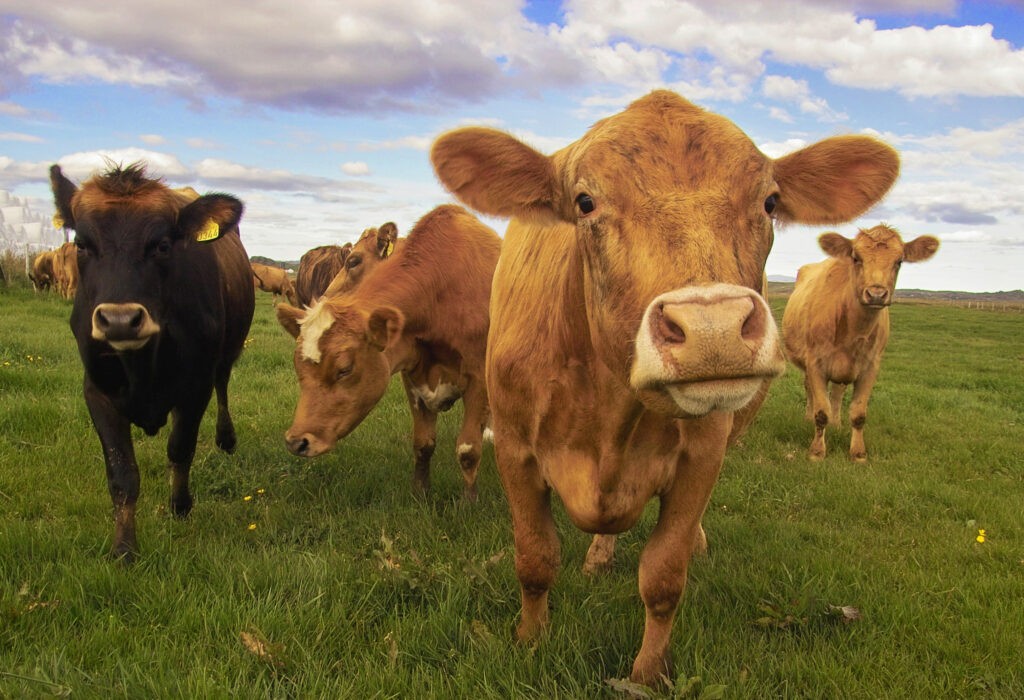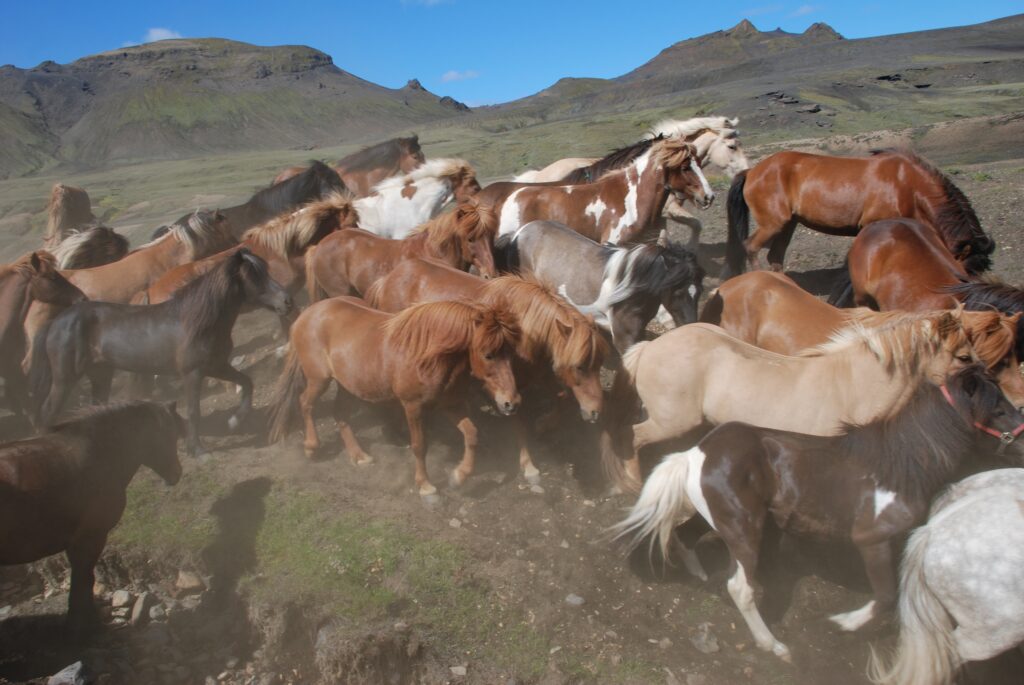Matís has, in recent years, systematically built up genetic analysis of animals and there are staff in the professional group genetics who is credited with it. Among other things, research is conducted on livestock, especially cattle, horses and sheep. The projects carried out mainly consist of genetic analyzes of these beneficial strains and data processing together with sequencing of the genetic material of organisms, the search for new genetic boundaries and the development of genetic analysis kits.
In Iceland, some livestock stocks are specifically Icelandic, while others are imported. Chickens and pigs, for example, are imported, but cattle, horses, sheep and goats are entirely of Icelandic stock. This means that Icelandic companies are the only ones in the world that carry out breeding of these four livestock stocks. The Agricultural Advisory Center (RML) is in charge of breeding these stocks. At Matís, we have mainly worked with three species, i.e. cattle, horses and sheep.
Cattle farming
Matís performs genetic analyzes that are useful in breeding the Icelandic cow population. The Icelandic strain is a unique strain in the world, distantly related to other breeds, and there are many indications that the protein composition of milk from Icelandic cows is different from other milk. It is extremely important to preserve this unique population, and one of the best ways to preserve livestock populations like this is to use them in the production of agricultural products.

The Farmers' Association and the Agricultural Advisory Center (RML) worked for several years on the implementation of so-called genome selection in cattle breeding, and Matís carries out the genetic analysis used in this. In short, breeding in cattle breeding is based on finding and using the best bulls in breeding work. To put it simply, the best bulls are those that produce the best daughters, i.e. heifers that milk a lot, are healthy and fertile. In genome selection, the breeding value of bull calves is calculated based on genetic parameters analyzed soon after calving. This methodology therefore greatly speeds up breeding and increases safety in the selection of the best bulls that are then used for insemination. Matís' genetics group analyzes between 6,000 and 8,000 artifacts per year.
horses
Matís offers parentage analyzes in horses, but those analyzes are an important part of the breeding work of the Icelandic horse, which has gained more importance in recent years. With parentage analysis, the pedigree of horses is scientifically confirmed and this greatly increases the safety of all breeding calculations. These analyzes are also done in close collaboration with RML. The staff of RML and other sampling parties take care of sampling from horses, which takes place in a similar way to what people used when they took a Covid test. Matís then isolates the genetic material and performs the genetic analyses. The staff of the genetics group analyze between 1,200 – 2,000 horses each year.

At Matís, work is currently being done to also offer genetic analyzes in other genetic sites in horses. Ideally, it is color genes and known genetic defects that we are looking at. The Icelandic horse is an extremely colorful horse breed and it is part of the breeding goals to maintain color diversity within the stock. Color in horses is determined by 8-12 genetic sites (genes) and it would be valuable for Icelandic horse breeders to have access to analyzes of these color genes. RML's recruiters have especially noticed an interest in this among foreign buyers of Icelandic horses.
Sheep
Genetic defects
Few genetic defects cause a lot of damage in Icelandic sheep breeding, and only two are serious problems, namely yellow fat and bökkreppa. Both are recessive genetic defects, meaning that individuals need two copies of the defective gene for them to be affected. Yellow fat is caused by a mutation in a gene that breaks down certain yellow compounds and causes the fat to acquire a yellowish color similar to the color of fat on horse meat. The yellow fat has no effect on the taste quality, but some production centers do not accept artifacts that show this genetic defect, and therefore this can cause financial losses for individual farmers. Matís is awaiting genetic analysis of yellow fat.
Bow crisis is a much more serious genetic defect. The gene is unknown, so there is still no genetic test that identifies carriers. The genetic defect is not known in other breeds of sheep, but the phenotype manifests itself as severely deformed front legs and lambs often cannot stand up. Most individuals are therefore euthanized shortly after birth. Because the genetic defect is recessive, the defective gene can be hidden in herds and it is impossible to eradicate the defect except through genetic analyses.
Matís has been conducting research on bow crisis in recent years, in collaboration with RML and Keldur, to find the genetic defect in the sheep's genome and develop a genetic test. The first results of these studies are expected in February 2024.
Fertility genes and parentage analyses
Two genetic variations are known in Icelandic sheep that cause increased fertility in ewes: Þoku- and Lóugen. These are mutations in the same gene. When the gene is in a heterozygous state, the fertility of females increases greatly and it is common for them to have four- and five-limbed offspring instead of one- and two-limbed offspring. This can therefore be an extremely important tool in sexual enhancement, and Matís has been offering analyzes of this feature for years.

Matís offers parentage analysis in sheep, comparable to parentage analysis in horses and dogs. A lot of rickets genes have been identified in recent years, and the situation has now arisen that the genotype of lambs does not match the genotype of the parents. Parentage analysis can be used to find the father of an offspring. These tests are an extremely useful tool in research, especially when looking for genetic defects.
Prion gene genotyping analyses
Matís has offered genotyping of the so-called prion gene in sheep since the company was founded. A total of about 10,000 sheep have been diagnosed with us. Rickets is a prion disease that has plagued Icelanders, especially in the last century but also in recent years. Prion diseases are different from bacterial and viral diseases, where the rubella agent is a protein. It therefore contains no genetic material. The rubella agent changes the structure of the natural prion protein, which is important in the nervous system of mammals. In a specific region of the prion gene, there are 6 sites that affect the susceptibility of sheep to scrapie. Three of these sites are very well known and three other sites in the gene are being investigated. The genotype of animals will in the near future be very important in breeding and the reaction of the Icelandic Food Agency when scabies is discovered in a herd.
Regarding the breeding side, RML aims to introduce protective genotypes very quickly in herds in parts of the country where rubella infection occurs regularly and steadily elsewhere in the country. With these methods and actions, it will be possible to spare certain genotypes from culling when scabies is detected in herds in the future. Matís has human resources and equipment to analyze genotypes in sheep. Considerable funds are expected in the 2024 budget for genotyping sheep, and Matís' staff is ready to take care of these analyses.
A podcast about heredity
Recently, a new episode of Matvælin, Matís' podcast about research and innovation in food production, was released. There was Sæmundur Sveinsson, genetics manager at Matís, interviewer, and he discussed genetic research and projects related to it in an easy-to-understand and fun way. It is possible to listen to the episode in its entirety on all major podcasts, but also here: Icelandic livestock species – genetic analyzes and breeding work

